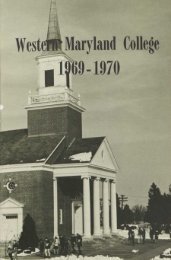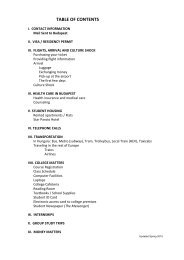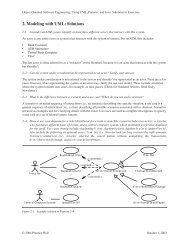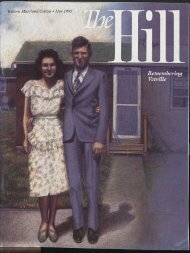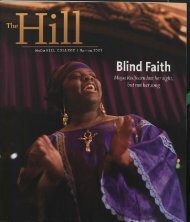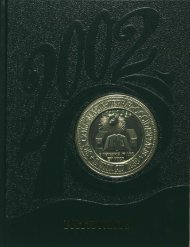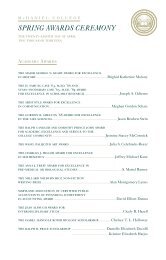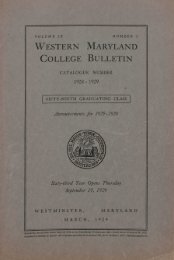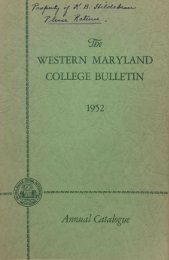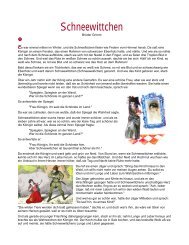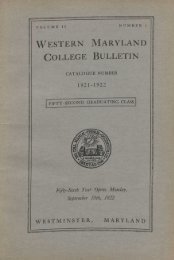You also want an ePaper? Increase the reach of your titles
YUMPU automatically turns print PDFs into web optimized ePapers that Google loves.
else as tall as I am!). In this colony we are to live andwork with the people as they live and work Houses willbe made of split branches from jungle trees and have apalm leaf roof and dirt floor and have just half a wall onthree sides so as to let in light and bugs. There may bea latrine and if we are lucky the water will be near andcome from a rushing mountain stream. Sun will beblisteringly hot, mosquitoes will drone incessantly, andwe'll have to keep a gun handy for protection fromsnakes and tigers and other such 'beasts." We'll growour food in a garden in back of the house, after we'vecleared the land, because we won't be able to affordthe time or money spent in town.All these things we are told and prepared for, and,our work is outlined.The first thing we'd do is go out and visit all thefamilies in the colony finding out things about eachhome. We'd have to be careful about using our specialtalents of teaching and nursing as superficial cures toneeds of the community. Our job is community development.Our motto is helping the colonists see their ownneeds in order to then help themselves. When we leaveafter three years, we don't want them to feel a gap, butrather to be a lot better equipped to resolve their ownproblems.Sound easy?? We have yet to see.It was the little cultural differences that were hardto get used to and griped the hell out of me because Icouldn't quite understand and couldn't get used to atfirst. I knew I had to live with them for three years andwas trying so hard to "identify" that I didn't dare getit out of my system. The disease is called "culturalshock" I believe. However, whether it's a good or badsign, one eventually adjusts to the clashes of cultures, andthe other day another team member and I laughed atourselves as we looked at the jacket of a Peter, Paul,and Mary album and remarked at how clean the Boorlooked]Letters and newspapers from WMC this spring indicatedan excitement in the air electrified by the personsof Boyd and Coffin.I couldn't help wishing that Boliviahad more Boyd and Coffins.There are many reasons whyBolivia is called a "Land-Divided"-climate, geography,customs, but most strikingly, race. The difference is thatthe repressed Bolivian Indian who makes up 80 percent ofthe population hasn't yet caught the spirit of U. S. Negroagainst the social injustice he suffers. In these pastmonths, our period of orientation has taken us all overBolivia. We have had a chance to observe firsthand andto participate in the life of the Bolivian Indian-and it iswith him that we'll be working for the next three years.Let me tell YOll more about our travels of the last fewmonths to give you a better idea about just why thisland has been named a "Land of Decision." Our travelshave taken us from west to east, from the Andes to thelowland jungles, from Lake Titicaca to the Brazilianfrontier.It was on the Altiplano that I watched Dr. Quirogaand a visiting doctor give a small Indian boy cause tosmile as they autographed the cast they had just put onhis TB infested leg. In the square four blocks away Icould hear the little brass bands playing the same notesover and over again from dawn until sunset callingAvmara for miles around to the annual ritual festival inthe town square. This was a change from the monotonyof the rugged primitive life on the shores of Titicaca.I sat imide a circle of Aymara women one Sundayafter church beside the shining blue waters of the lakeand added some fruit to the potatoes and beans andcom spread out on little knitted squares in front of me.A few yards away the men were similarly gathered.Many times my thoughts would wing homeward-for onthe Altiplano it's hard to believe that across the watersand over the high peaks is the fast-moving society whereties are kept. All around are little adobe huts with noventilation-black with smoke from the cooking fire, littlegirls watching their herds, men and women knitting asthey walk along the dirt roads in shoes made out of oldrubber tires, diaperless babies haltered over the backof a black-braided, derby-hatted mother. Bringing me intouch with the 20th century always, however, are theAltiplano status symbols of the English bike and transistorradio-breaking the bonds of tradition.But the young, forward-looking colonists of Bolivia,moving into new, rich lowland territory to colonize, arethe real signs of a break from the chains of tradition andthe worn-out Altiplano soil. These are the "Pioneers" ofthe land, the brave ones. The land is rich, but so differentfrom what they've known. Problems are differenthowto plant new types of crops, how to prevent erosion,how to keep the pigs and chickens from dying, how tokeep new tropical diseases from the family, how to getproducts to market without roads how to go throughagencies to get help to combat all these new problems????With the problems, however, there's a big differencebetween the colonist and his Altiplano father andmother. The colonist is on the front lines, eager for abett~r life and willing to accept changes to bring abouta brIghter future for his children.To give a better idea, here are answers I've gottenfrom a preliminary questionnaire in the colony of SanPablo, my home.Can you speak Spanish? (to a mother) Janiwa.h, Aymara.(No, Aymera-cnother tongue)Can you read and write? No (80 percent of adults areilliterate.)What plans do you have for your children? I wantthem to live.pageten




